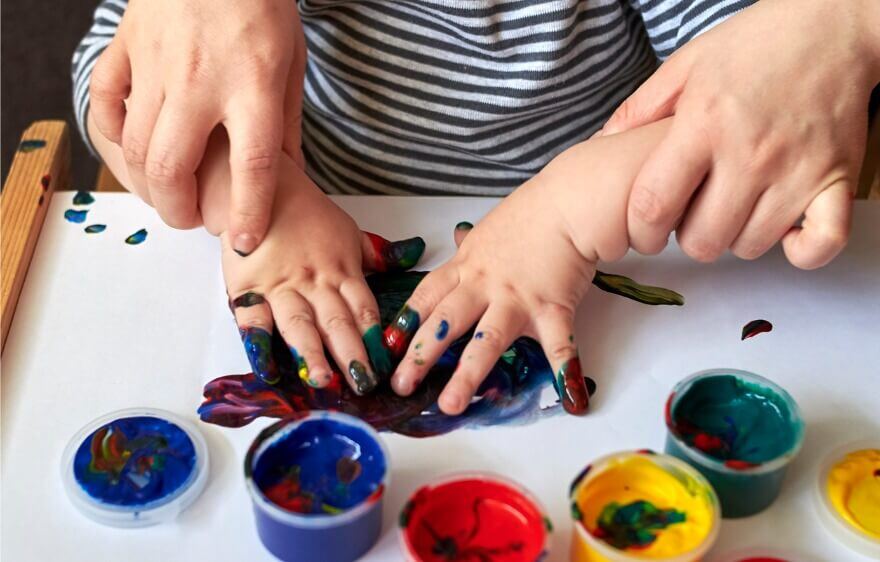Have you experienced the wonders of sensory play? Beyond being fun, it’s an essential part of child development that can make a huge difference in your therapy sessions! Whether you’re an occupational therapist, physical therapist, speech therapist, or another type of pediatric practitioner, sensory play is a fantastic tool to have in your arsenal. Let’s explore what sensory play is, why it’s so important, its benefits, and how you can incorporate it into your sessions.
What Is Sensory Play?
Sensory play includes any activity stimulating a child’s senses: touch, smell, taste, sight, and hearing. It also includes movement and balance (vestibular) and body awareness (proprioception). Essentially, sensory play is about engaging the senses to help children explore and understand the world around them.
Some classic examples of sensory play activities include:
- Playing with sand or water
- Finger painting
- Playing with playdough or slime
- Exploring textured objects
- Scented playdough or scented markers
- Listening to different types of music or sounds
- Balancing on a beam or swinging
These activities not only engage the senses but also encourage children to explore, create, and learn in a natural and enjoyable way.
Why Is Sensory Play Important?
Sensory play is crucial for a child’s development for several reasons:
- Brain Development: Sensory play helps build nerve connections in the brain’s pathways, which are crucial for all types of learning. These connections enable children to complete more complex learning tasks and support cognitive growth, language development, and social interaction.
- Motor Skills: Many sensory play activities involve fine and gross motor skills. Playing with small objects can improve fine motor skills and hand-eye coordination, while jumping or climbing enhances gross motor skills and balance.
- Emotional Regulation: Sensory play can be incredibly calming for kids. It helps them learn how to regulate their emotions, manage anxiety, and deal with sensory overload. Activities like playing with playdough or listening to soothing sounds can be calming and reduce stress.
- Social Skills: Sensory play often involves group activities where children learn to share, take turns, and communicate with their peers. This social interaction is vital for developing strong communication and social skills.
- Language Development: Describing textures, smells, or sounds during sensory play can boost vocabulary and language skills. Through sensory experiences, kids learn to express themselves more effectively and understand new concepts.
Benefits of Sensory Play
Now that we know why sensory play is important, let’s look at some specific benefits it offers:
- Enhances Learning: Sensory play supports learning in a fun, hands-on way. It helps children understand and retain new information by engaging multiple senses simultaneously. For example, when a child plays with sand, they learn about texture, weight, and volume all at once.
- Promotes Cognitive Growth: Sensory activities encourage exploration and problem-solving. Children who manipulate objects and materials develop critical thinking and decision-making skills.
- Supports Physical Development: Through activities like climbing, swinging, or balancing, sensory play promotes physical fitness and strengthens muscles. Fine motor activities like threading beads or tweezers enhance hand strength and dexterity.
- Improves Focus and Attention: Engaging in sensory play can improve a child’s ability to focus and pay attention. It provides the sensory input they need to stay alert and engaged, which is particularly beneficial for children with attention difficulties.
- Boosts Creativity and Imagination: Sensory play encourages creativity and imaginative thinking. Using sensory materials, children can create stories, scenarios, and artwork, which enhances their creative skills.
- Builds Social Skills: Sensory play often involves cooperative play with peers, which helps children develop social skills such as sharing, negotiating, and collaborating. It also provides opportunities for children to practice communication and empathy.
- Provides Sensory Input: For children with sensory processing issues, sensory play can provide the sensory input they need to stay regulated and comfortable. It helps them process and respond to sensory information more effectively.
How Can Therapists Incorporate Sensory Play Into Their Sessions?
Incorporating sensory play into therapy sessions can be a game-changer for your practice. Here are some tips and ideas for making the most of sensory play with your clients:
- Assess Sensory Preferences: Start by assessing each child’s sensory preferences and needs. Some children may seek out certain types of sensory input, while others may be more sensitive to specific stimuli. Understanding these preferences will help you tailor activities to each child.
- Create a Sensory-Friendly Environment: Set up a sensory-friendly space in your therapy room. Include various sensory materials and tools such as textured fabrics, sensory bins filled with rice or beans, scented playdough, and a selection of music or white noise.
- Incorporate Sensory Play into Goals: Align sensory play activities with the child’s therapy goals. For example, if a child needs to improve fine motor skills, use playdough, threading beads, or sensory bins to work on hand strength and dexterity. If a child needs to develop social skills, incorporate group sensory activities encouraging cooperation and communication.
- Use Sensory Bins: Sensory bins are a fantastic tool for sensory play. Fill a bin with materials like rice, beans, sand, or water, and add small toys or tools for the child to explore. Sensory bins can be tailored to different themes or therapy goals, making them versatile and engaging.
- Incorporate Movement: Include activities that involve movement and balance, such as obstacle courses, balance beams, and swings. These activities provide vestibular and proprioceptive input, which is essential for sensory integration.
- Offer Choices: Give children a variety of sensory play options to choose from. This empowers them to take control of their play and engage in activities that meet their sensory needs. Offering choices also encourages decision-making and independence.
- Combine Sensory Play With Other Therapies: Sensory play can be integrated with other therapeutic approaches, such as speech, physical, and cognitive-behavioral therapy. For example, you can use sensory activities to facilitate speech and language development or incorporate sensory elements into physical exercises to make them more engaging.
- Monitor and Adjust: Continuously monitor the child’s response to sensory activities and adjust as needed. Some activities may be too stimulating or not stimulating enough, so it’s important to be flexible and responsive to the child’s needs.
- Educate Parents and Caregivers: Teach parents and caregivers how to incorporate sensory play into their child’s daily routine. Provide them with ideas and resources for sensory activities at home, and explain the benefits of sensory play for their child’s development.
- Document Progress: Keep track of the child’s progress and any changes you observe in their behavior, skills, or emotional regulation. Documenting progress will help you adjust your therapy plan and demonstrate the effectiveness of sensory play interventions.
Sensory Play Activity Ideas
Here are some fun and easy sensory play activities that you can incorporate into your therapy sessions:
- Sensory Bottles: Fill clear plastic bottles with various materials, such as water, glitter, beads, or sand. Children can shake the bottles and observe the contents, which provides visual and auditory stimulation.
- Shaving Cream Play: Spread shaving cream on a table or tray and let children use their hands to explore the texture. They can draw shapes, letters, or numbers in the cream, supporting fine motor skills and early literacy.
- Bubble Wrap Stomp: Lay out bubble wrap sheets and let children stomp on them to make popping sounds. This activity provides tactile and auditory input and can be a great way to release energy.
- Sound Matching: Fill small containers with different materials like rice, beans, or pebbles. Have children shake the containers and match the sounds to the corresponding materials. This activity enhances auditory discrimination and memory.
- Edible Playdough: Use edible ingredients like flour, salt, water, and food coloring. Children can explore the taste and texture, providing tactile and gustatory input.
- Nature Walk: Take children on a nature walk and encourage them to collect various natural items like leaves, rocks, and flowers. Discuss the different textures, smells, and colors, and use the items for further sensory exploration back in the therapy room.
- Ice Excavation: Freeze small toys or objects in ice blocks and let children use tools like spoons or small hammers to excavate them. This activity provides tactile and proprioceptive input and encourages problem-solving.
- Light Table Activities: Use a light table to explore transparent or translucent materials like colored plastic shapes, gels, or water beads. The illuminated surface enhances visual input and makes the exploration more engaging.
- Water Play: Set up a water table with cups, spoons, and small toys for children to explore. Water play provides tactile and proprioceptive input and can be soothing for many children.
- Textured Art: Create art projects using materials with different textures, such as sandpaper, cotton balls, and fabric scraps. Children can create collages or textured drawings supporting tactile exploration and creativity.
We Encourage Creative Play
At Care Options for Kids, we encourage our therapists to explore sensory play in their sessions to engineer the best outcomes unique to their clients’ needs. Incorporating sensory activities into therapy can enhance learning, improve motor skills, support emotional regulation, and build social and communication skills. Embrace the magic of sensory play, and watch your young clients thrive!
Join the Care Options For Kids Team!
Are you ready for meaningful work that comes with benefits and not burnout? Join the compassionate care team that helps children and families live their best lives. Our clinicians provide best-in-class pediatric nursing, therapy, and school-based services. We bring individualized care to children where they live, work, and play. We have opportunities in homes, schools, and clinics across the country.
Apply at Care Options for Kids now. We make it easy to start so you can make a difference as soon as possible.






